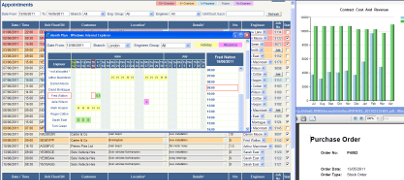

Expeto is a business management system for small to medium engineering companies in the service and repair industry. Expeto helps you plan engineers time, manage stock and accurately monitor costs and service levels to help you deliver outstanding customer service.

Many companies suffer problems when implementing information technology (IT) systems with projects completing late, over budget or suffering significant setbacks. The buzzwords and jargon designed to sell systems and their implementation only serve to confuse and despite claims to the contrary there is no 100% guaranteed foolproof implementation methodology. The most common reasons for project failure are often due to system selection, implementation and the difficulties of aligning IT with the cultural practices of the organisation.
Before embarking upon the process of selecting and implementing an IT system it is important to understand your current business processes and define the real problems that need to be addressed. This can often be achieved by creating flow charts of your processes and interactions between the key functional areas. A vision for the future needs to be established again using high level flow charts and descriptions of the major tasks. This process should result in a list of functional requirements by which you can evaluate software packages and a set of measurements which quantify your current performance and can be used to provide an indication of progress.
One of the critical factors to your success is securing the buy-in of the system users. Often employees fail to understand that information systems are part of a company’s infrastructure, and are strategic to the organisations survival and success. As the working life of your employees will change it is important that they participate in the configuration and implementation of the system. This will foster a sense of commitment within your organisation and ownership of the new systems and processes. As user involvement requires time and effort from employees who are probably already working to stretched schedules it is important that you make the priority clear.
Poor software selection often occurs when the limitations of your current business processes are inadequately defined and too little forethought is given to the proposed future processes. In these cases it is possible to select a software package that does not meet the current needs and future aspirations of your business. It can also occur when the users evaluating the software package do not take the time to run the screens of the system as they would during their daily work tasks to ensure that the features are adequate for their needs.
The selection and implementation of a business system will take considerable time and effort. As it is an exercise in changing the way your company goes about its business it is important that the best people that you have available are used for the project team. The selection of those involved often reflects the precedence given to the project, therefore apply the adage “if it doesn’t hurt, use someone else”. It is not essential that those involved understand IT systems although this undoubtedly helps. What is of greater importance is that they understand the business, products, markets and processes and the capabilities of the people within your organisation. It is this knowledge on which the decisions needed during system configuration will be based.
The data migration phase is often underestimated but can consume a large part of the project resource. It is important that your legacy data is clean, relevant and recent. There is little benefit of importing the data of suppliers, customers, parts etc… that you no longer use. Equally, the inventory count needs to be accurate with a full stock-take immediately prior to system live date. A failure to ensure accurate, reliable data at start-up can only result in significant complications at a later date.
The objective of a pilot is not just to confirm that the system works but that the new systems and processes meet the needs of your business. The initial pilots usually confirm individual functional areas. This should progress to the final pilot which should confirm that the different areas cohere to provide an integrated solution. This must include all supporting paperwork. At this stage it is invaluable to get your key system users involved as they may pose questions that the implementation team may have missed. Any issues raised during the pilot should be addressed before the system goes live.
Changes to the business processes can often result in changes to your employee’s area of responsibility. These need to be discussed and agreed with employees prior to training to ensure that the users understand their new responsibilities and are trained in the appropriate areas. The training needs to cover the new processes for each functional area and any interactions with other areas of the business. This should be supported with simple documentation of the new processes.